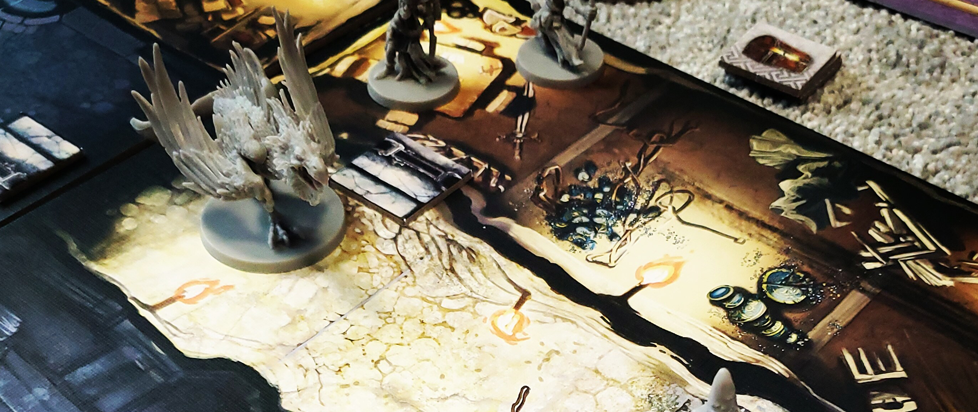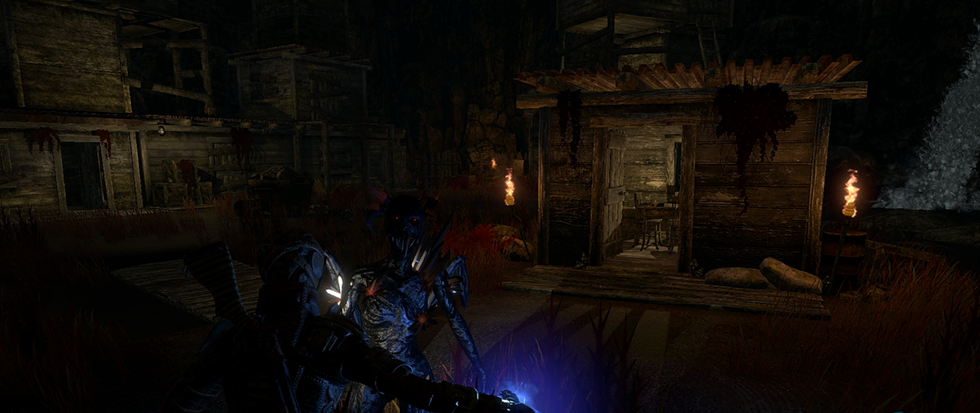
Darkness of Unusual Size: The Sword-and-Sorcery Answer to Descent
I see board games in the store and they always look so cool and then I buy them and bring them home, I’m so excited to open them, and then I play them, like, twice… This column is dedicated to the love of games for those of us whose eyes may be bigger than our stomachs when it comes to playing, and the joy that we can all take from games, even if we don’t play them very often.
Not that long ago, I got pulled into the (hugely successful) Kickstarter for the sequel to Massive Darkness, which made me curious to check out the original. By the time I did, I had already played (and loved) Descent, as I mentioned in an earlier column.
If Descent is what we’ve all come to expect from a modern high fantasy D&D-alike, then Massive Darkness is its lo-fi sword-and-sorcery equivalent. Its (undercooked) setting is filled with loincloths and dark caves, complete with an art style that looks like it could have been pulled straight off MTV’s Liquid Television in the ‘90s.
This lower-fantasy approach often works in the game’s favor – and always helps to distinguish it from competitors like Descent. I’d stop short of calling Massive Darkness either “dark” or “gritty” – it’s no Shadow of the Demon Lord or even Warhammer Fantasy. It’s too cartoony for that. But it is both more and less granular than Descent, with a heavy focus on what’s going on in a particular room and what’s waiting just beyond the next door.
At the same time, the rules in Massive Darkness eschew any sense of physical realism in favor of ease of play. In my post on Descent, I mentioned the line-of-sight issues that so often plague games like this. Massive Dark gets around them by simply making it so characters can’t see diagonally. It’s straight lines or nothing!
This is possible in part because of the floor tiles the game uses. While Massive Darkness was my first encounter with them, they actually seem to be somewhat standard for games from manufacturer CMON. Arcadia Quest uses basically the same tiles, as does its outer-space equivalent as well as Zombicide, a game with which Massive Dark actually shares a lot of commonalities and is at least semi cross-compatible, with the right add-ons.
All of these games use floor tiles of uniform size, made up of nine large squares instead of a one-inch grid in D&D proportions. These large squares can hold several models, and render movement into much less incremental terms.
The floor tiles in Massive Darkness look great, and may be the best implementation of the game’s art style. There’s a softness to the edges that makes the whole thing feel somewhat unfinished in an appealing way, and the game’s light and shadow mechanic is incorporated into the tile art in ways that are at once immediately identifiable and don’t feel too mechanical. (No equivalent of the icons or colored borders that other games in the dungeon crawl subgenre rely on.)
That light/shadow mechanic – each character has a special ability that is only available to them when they are in an unlighted square – may be (partly) where the game gets is name, but they are far from its most intriguing rules innovation.
The thing that will stick out most immediately about Massive Darkness – for those who have played other games of this type – is the way character advancement is handled. While Massive Dark has rules for playing campaigns linking quests together, the core game design incorporates on-the-fly acquisition and spending of experience points.
Essentially, you gain XP every time you kill something – and you will be killing a lot of things in this game – and you spend it each turn. Meaning that your character may potentially “level up,” gaining new skills and abilities, in every round of play.
I said before that Massive Darkness is always preoccupied with what was behind the next door, and that plays into this on-the-run leveling system. Each floor tile (which is only nine spaces) is a “level” of the dungeon, meaning that whenever you go to a new floor tile, the monsters get tougher, and the magic items get better.
It’s essentially an entire campaign’s worth of advancement crammed into a single setting. As in Descent, character advancement happens based on the class that you choose, with each one getting a series of ability tracks that you can spend your XP on as you go. These may do everything from giving you better attacks to increasing your health to teaching you new spells, and you’re likely to get a new one every turn or two.
It’s an innovative mechanic, as I said, but it’s also something else – an appropriate one, helping to play into the lower-stakes, less ambitious fantasy setting. This isn’t about toppling a kingdom – or saving one. While there’s a backstory about the eponymous Darkness and how you’re saving the world from it, the real meat of Massive Darkness is about descending into a grimy dungeon and killing every single thing you find.
And, as I mentioned, this is a CMON game, so you will find a lot of things to kill. As was the case with Rum & Bones, which I covered previously, this game is lousy with minis. It was also funded by Kickstarter, so there are plenty of expansions and Kickstarter-exclusive heroes and monsters out there on the secondary market, if you’re inclined to track them down – though, as is often the case with such things, they may cost you a pretty penny.
But the core box comes packed with plenty of plastic, including numerous duplicate copies of the various mobs of enemies that you’ll encounter – mostly made up of old standards like goblins, orcs, and sinister dwarves. In addition to mobs, there are wandering monsters such as trolls, ogre mages, demons, and an absolutely ridiculously huge giant spider, because all fantasy settings are required by law to incorporate giant spiders, don’t you know?





